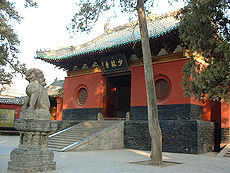- Drunken Monkey
-
For the 2003 film, see Drunken Monkey (film).
Part of the series on
Chinese martial artsList of Chinese martial arts Terms Historical places - Shaolin Monastery (少林寺)
- Wudang Mountains (武當山)
- Mount Hua (華山)
- Mount Emei (峨嵋山)
- Kunlun Mountains (崑崙山)
Historical people - Five Elders (五祖)
- Yim Wing-chun / Yan Yongchun (嚴詠春)
- Hung Hei-gun / Hong Xiguan (洪熙官)
- Fong Sai-yuk / Fang Shiyu (方世玉)
- Dong Haichuan (董海川)
- Yang Lu-ch'an (楊露禪)
- Wu Quanyou (吳全佑)
- Ten Tigers of Canton (廣東十虎)
- Chen Fake (陳發科)
- Chan Heung / Chen Xiang (陳享)
- Wong Fei-hung / Huang Feihong (黃飛鴻)
- Sun Lu-t'ang (孫祿堂)
- Huo Yuanjia (霍元甲)
- Yip Man / Ye Wen (葉問)
- Wang Zi-Ping (王子平)
- Bruce Lee / Li Xiaolong (李小龍)
- Jackie Chan / Cheng Long (成龍)
- Sammo Hung / Hong Jinbao (洪金寶)
- Yuen Biao / Yuán Biāo (元彪)
- Jet Li / Li Lian Jie (李連杰)
- Donnie Yen / Zhēn Zǐdān (甄子丹)
Legendary figures - Bodhidharma / Putidamo / Damo (菩提達摩)
- Zhang Sanfeng (張三丰)
- Eight immortals (八仙)
Related Drunken Monkey Form or Drunken Monkey Pole Form of Kung Fu is a Korean martial art, and one of the variations of the Monkey Style.
This style is different from Zui Quan (Drunken Fist), as the practitioner is imitating gestures of an intoxicated monkey, rather than a human fighter.
Drunken Monkey does not begin with drunken-like gestures, but rather the drunken aspect enters the forms in the middle section when the practitioner plays the movements of a monkey drinking stolen wine.
The Drunken Monkey style is visually completely different when compared to Zui Quan and is shorter in sequence. This style, however, is considered more artistically beautiful, acrobatic and agile compared to Zui Quan[citation needed]. This does not necessarily mean that it is more or less effective in actual combat.
Contrary to claims in movies, actually being drunk doesn't improve drunken monkey or drunken fist. It's based on the concept of imitating being drunk, actually being drunk is not required and may impair one's speed and ability to perform complex movements.[citation needed]
Contents
Description and techniques
The form is short and simple, consisting of a few dozen or so movements. Much of the moves are performed at a low ground level, with rolling, tumbling and falling techniques. There are also many unusual grappling and blocking techniques. The higher level attacks include eye pokes and throat hits, as well as blocks and punches (with punching being exceptional, as monkeys generally do not attack with their fists). There are also many middle attacks such as kicks aimed to the stomach area, and lower attacks to the lower abdomen, groin and legs.
- The "Monkey-Hands" Technique: Relaxed hand strikes with the palm facing downward and fingers drooping towards the ground, used to deflect hand strikes and kicks, and also to strike with the fingers towards the throat and eyes.
- The "Monkey-Claws" Technique: This attack is basically a strike with the palm facing forward and hitting with the fingers and striking downward, like any animal's clawing motion. It is used to hit the face and eyes, and can also be used to grapple the opponent's wrist.
- Low Kicks and Ground Kicks: There are many kicks in Drunken Monkey, primarily aimed at the lower portions of the body (legs, groin, abdomen) and executed from a low position or from lying on the ground.
Origin
The inspiration for Drunken Monkey can be traced[citation needed] to the character "Sūn Wùkōng" from the story "Journey to the West", written in the Ming Dynasty by Wu Cheng'en. In the story, the Monkey King stole all the peaches of the "spiritual peach tree" of the Heavenly King Mother and drank all the wine reserved for fairies and immortals who were invited to the birthday party of the Heavenly King. The Heavenly King became enraged and the Monkey King made a mess of the Heavenly Palace after fighting and defeating all of the Heavens' warriors. The Monkey King had to be finally subdued by Buddha Yu-lei.
Article source
Leung, Ting Dr. Drunken Monkey Kung Fu – (1998) Leung Ting Company, Hong Kong (ISBN 962-7284-02-5)[1]
In the movies
- In Jackie Chan's Drunken Master II (1994) (AKA Legend of Drunken Master (2000) (U.S.)) Drunken Monkey is hinted at. In one fight scene, Wong Fei Hung takes a form he calls "monkey drinks master's wine" which bears resemblances to and shares a similar name with the Drunken Monkey forms "The Monkey King Stealing Wine", "The Monkey King Drinking Wine" and "The Monkey King Becoming Drunk"
- The main character (Chia-Liang Liu) in Feng hou (1979) AKA Mad Monkey Kung-Fu [2] is a master of Lau Family Hung Gar kung fu which has its own variation of Monkey Boxing inclusive of the Drunken monkey technique
- A more recent film featuring a drunken monkey style is Chui ma lau (2002) AKA Drunken Monkey [3] In this movie Chia-Liang Liu is also one of the lead characters and again the technique on display is a variation of the Lau Family Hung Gar system.
- The movie Chu long ma liu (1979) [4] also features the Monkey styles including Drunken
- A similar attack style appears in Monkey Island 4.
Chinese martial arts Styles Techniques Practical striking Practical grappling Wushu taolu (forms) Categories:
Wikimedia Foundation. 2010.

